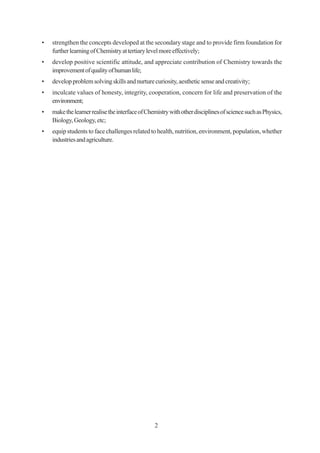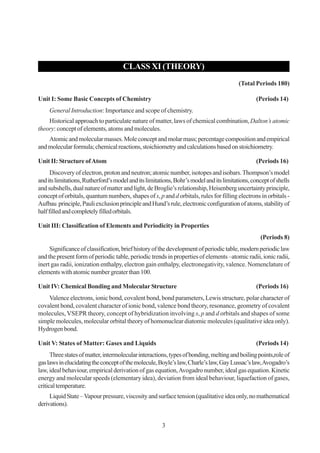This document provides the rationale and syllabus for chemistry classes XI-XII. It discusses that at the higher secondary stage, specialized discipline-based courses are introduced to prepare students for careers in basic sciences or professional fields. The syllabus aims to provide a conceptual background in chemistry and promote problem-solving abilities. It covers fundamental concepts logically and relates chemistry to modern applications. The practical syllabus includes core experiments and an investigatory project. The overall goals are to develop scientific skills and attitudes while retaining interest in chemistry.





![PRACTICALS
Total Periods 60
Micro-chemical methods are available for several of the practical experiments. Wherever possible
such techniques should be used.
A. Basic Laboratory Techniques
(Periods 2)
1. Cutting glass tube and glass rod
2. Bending a glass tube
3. Drawing out a glass jet
4. Boring a cork
B. Characterization and Purification of Chemical Substance
(Periods 6)
1. Determination of melting point of an organic compound.
2. Determination of boiling point of an organic compound.
3. Crystallization involving impure sample of any one of the following:
Alum, copper sulphate, Benzoic acid.
C. Experiments Related to pH Change
(Periods 6)
(a) Any one of the following experiments:
• Determination of pH of some solutions obtained from fruit juices, solutions of known and
varied concentrations of acids, bases and salts using pH paper or universal indicator.
• Comparing the pH of solutions of strong and weak acid of same concentration.
• Study the pH change in the titration of a strong acid with a strong base using universal indicator.
( b) Study of pH change by common-ion effect in case of weak acids and weak bases.
D. Chemical Equilibrium
(Periods 4)
One of the following experiments:
(a) Study the shift in equilibrium between ferric ions and thiocynate ions by increasing /decreasing
the concentration of either of the ions.
(b) Study the shift in equilibrium between [Co (H2O)6]2+and chloride ions by changing the concentration
of either of the ions .
E. Quantitative Estimation
(Periods 16)
•
Using a chemical balance.
•
Preparation of standard solution of oxalic acid.
•
Determination of strength of a given solution of sodium hydroxide by titrating it against standard
solution of oxalic acid.
•
Preparation of standard solution of sodium carbonate.
6](https://image.slidesharecdn.com/desmschemistry-140107072008-phpapp02/85/Desm-s-chemistry-6-320.jpg)






